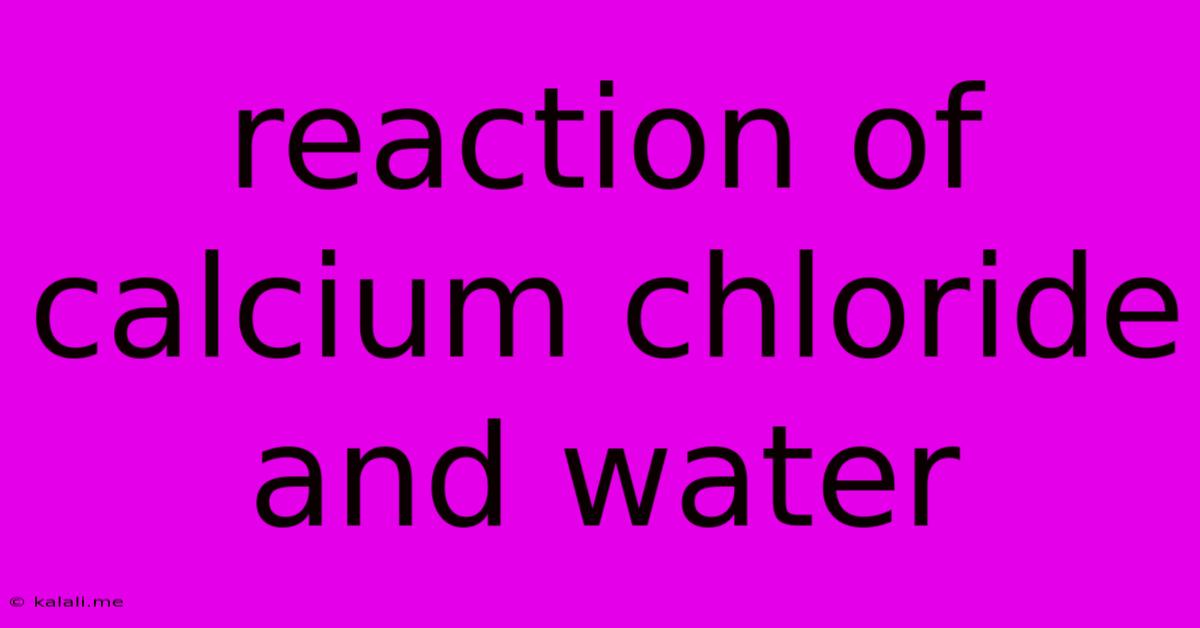Reaction Of Calcium Chloride And Water
Kalali
Jun 12, 2025 · 3 min read

Table of Contents
The Exothermic Reaction of Calcium Chloride and Water: A Deep Dive
The reaction between calcium chloride (CaCl₂) and water (H₂O) is a classic example of an exothermic reaction, meaning it releases heat. This seemingly simple reaction has significant implications in various applications, from de-icing roads to industrial processes. Understanding the chemistry behind this reaction is key to appreciating its widespread use. This article will explore the details of this reaction, including the chemical process, safety precautions, and practical applications.
The Chemistry Behind the Heat: Dissolution and Hydration
When calcium chloride is added to water, it dissolves, forming an aqueous solution. This dissolution process is highly exothermic due to the hydration of calcium and chloride ions. Hydration refers to the process where water molecules surround the ions, forming a hydration shell. The strong electrostatic attraction between the polar water molecules and the charged ions releases a significant amount of energy in the form of heat.
This energy release is due to the formation of strong ion-dipole interactions. The positive calcium ions (Ca²⁺) are attracted to the negatively charged oxygen atoms of water molecules, while the negative chloride ions (Cl⁻) are attracted to the positively charged hydrogen atoms. The energy released during the formation of these bonds overcomes the energy required to break the existing bonds in the crystal lattice of calcium chloride and the hydrogen bonds in water.
The overall reaction can be represented as:
CaCl₂(s) + H₂O(l) → Ca²⁺(aq) + 2Cl⁻(aq) + heat
The "aq" denotes that the ions are dissolved in water. The heat generated is a direct result of the favorable enthalpy change (ΔH) of the reaction.
Safety Precautions: Handling Calcium Chloride and Water
While the reaction itself isn't inherently dangerous, certain safety precautions should be taken, especially when dealing with large quantities of calcium chloride.
- Eye protection: Always wear safety goggles to protect your eyes from splashes. The exothermic reaction can cause the solution to splatter.
- Gloves: Wear gloves to prevent skin irritation from prolonged exposure to the solution.
- Ventilation: Ensure adequate ventilation, particularly when handling large quantities of calcium chloride, as the reaction can generate some heat and potentially release small amounts of hydrogen chloride gas in the presence of strong acids.
Applications of the Exothermic Reaction: From De-icing to Desiccants
The exothermic nature of the calcium chloride and water reaction makes it valuable in several applications:
- De-icing: Calcium chloride is a common ingredient in de-icing agents for roads and sidewalks. The heat generated during dissolution helps melt ice and snow more effectively than using salt alone, and it remains effective at lower temperatures.
- Construction: It's used as an accelerator in concrete mixes, speeding up the setting process.
- Desiccants: Anhydrous calcium chloride is a powerful desiccant, meaning it absorbs moisture from the air. This property makes it useful in drying agents and preserving materials.
- Food Industry: It's used as a firming agent and in some food preservation techniques.
Conclusion: A Powerful Reaction with Diverse Applications
The seemingly simple reaction between calcium chloride and water is a powerful example of an exothermic process with numerous practical applications. Understanding the underlying chemistry and taking necessary safety precautions are crucial when working with this reaction. The significant heat released, combined with its other properties, makes calcium chloride a versatile and widely used chemical. Further research into optimizing its use in various fields continues to expand its impact on industry and everyday life.
Latest Posts
Latest Posts
-
A Step Up Transformer The Voltage And The Current
Jun 13, 2025
-
Which Of The Following Would Be
Jun 13, 2025
-
What Is The Largest Storage Device On A Computer
Jun 13, 2025
-
Transfer Function Of Low Pass Rc Filter
Jun 13, 2025
-
How Many Valence Electrons Are In Rubidium
Jun 13, 2025
Related Post
Thank you for visiting our website which covers about Reaction Of Calcium Chloride And Water . We hope the information provided has been useful to you. Feel free to contact us if you have any questions or need further assistance. See you next time and don't miss to bookmark.